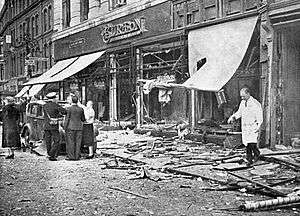1939 Coventry bombing

The Coventry bombing of 25 August 1939 was carried out by the Irish Republican Army as a part of its S-Plan campaign of bombing English cities to aid the German cause, having taken place nine days before the outbreak of World War II.[1][2] A bomb was left in Coventry city centre in the West Midlands, which resulted in 5 deaths and 70 injuries.[2][3] In response, two IRA members were executed, whilst another escaped to Ireland.[2][4] It was the first bombing of the campaign to kill civilians although it is claimed by those involved to be an accident.[3]
Attack
On 25 August 1939 at around 1.40pm, an Irish Republican Army member left a bomb in the basket of a bicycle, which was left against a kerb outside Astley's shop in the busy Broadgate area of Coventry.[2][3] At 14:32 the 5.1 lb (2.3 kg) bomb exploded killing five people and injuring seventy.[2][3]
The bicycle is said to have been bought by the leader of th group James McCormick who used the alias James Richards in Halfords, with the bomb stored at his lodgings in 25 Clara Street.[2][3] The potassium chlorate to be used in the bomb was then brought by train to Coventry by IRA transport officer, Peter Barnes, who returned to London the same day.[2][3]
The five who died were: Elsie Ansell, 21; John Arnott, 15; Rex Gentle, 30; James Clay, 82; Gwilym Rowlands, 50.[2] Ansell, who was closest to the blast, was only identifiable by her engagement ring.[2]
Arrest and trial
Barnes was arrested first and a raid at his lodgings in Westbourne Terrace, London, found damning evidence in regards to the Coventry bombing.[3] He was also linked to three "bicycle bomb" plots in London.[3] On 28 August, the Coventry City Police along with Special Branch raided the lodgings at 25 Clara Street, where equipment for making bombs was discovered and the five occupants arrested.[3] Initially released pending deportation, those arrested at Clara Street where re-arrested on 2 September.[3] On 27 September, Barnes, McCormick, along with Joseph Hewitt, Mary Hewitt, and Brigid O'Hara, were charged with the murder of Elsie Ansell, one of the bomb victims.[3] Joby O'Sullivan who had planted the bomb said he wasn't caught because the authorities were expecting him to get a ferry at Holyhead back to Ireland. Instead he got a train to London and stayed there "until everything died down."[2]
The trial took place at Warwick Assizes, Birmingham.[3] Both Hewitt's as well as O'Hara were acquitted.[3] Barnes and McCormick however were sentenced to death for their part in the bombing.[2] Barnes claimed during his trial that their orders where not to endanger life.[2] Prior to their executions the Irish Free State government led by Éamon de Valera several times appealed for their sentences to be commuted.[1] The requests were refused and Barnes and McCormick where hanged at Winson Green Prison on 7 February 1940.[1][3] As they were being led to the execution, Barnes continued to plead his innocence, whereas McCormick stood defiant saying "As a soldier of the Irish Republican Army, I am not afraid to die for I am dying in a just cause."[3] They were buried in unmarked graves.[1]
Aftermath
Both Barnes and McCormick were seen as martyrs back in Ireland, and had their bodies exhumed and repatriated back home.[2]
Many Irish people living in Coventry after the bombing found that the city's attitude had turned against them even though most of them had no IRA sympathies.[2] Some Irish were told to find new lodgings, whilst strike action was threatened in factories unless they withdrew all 2,000 Irish labourers.[2][3] An anti-IRA protest march was staged in Baginton by thousands of workers of Armstrong Whitworth.[3] The chief constable of Coventry, Captain Hector, had to issue a denial saying that he was "perfectly good Sommerset man" and not Irish.[2][3]
The outbreak of World War II on 3 September saw the bombing quickly leave the headlines.[2] The Blitz of 1940 saw Coventry's centre, including the Broadgate area, totally destroyed, thus leading to the Coventry bombing to be described as the forgotten bombing.[3][4]
The bomb was believed to have been meant for the an electricity generating plant in the outskirts of Coventry.[3] However in 1969 whilst speaking to Irish journalist, Mike Burns, O'Sullivan is claimed to have planted the bomb and said that the intended target was a police station and that the bike kept get getting stuck in tram tracks meaning it had to be abandoned.[2]
Following the beginning of World War II five days later, on 14 November 1940 the Broadgate area, as well as much of Coventry city centre, was almost destroyed by the Luftwaffe in the Coventry Blitz.[5]
Memorial
In October 2015 a sandstone monument was unveiled in the grounds of Coventry Cathedral.[3] A few dozen people gathered to witness it being unveiled, including relatives of four of the dead.[4]
References
- 1 2 3 4 "Garda assassinations and IRA executions during the Emergency". "The Irish Times".
- 1 2 3 4 5 6 7 8 9 10 11 12 13 14 15 16 17 18 "Coventry IRA bombing: The 'forgotten' attack on a British city".
- 1 2 3 4 5 6 7 8 9 10 11 12 13 14 15 16 17 18 19 20 21 "How history forgot IRA bombing of Coventry on the eve of World War II". "Coventry Telegraph.
- 1 2 3 "Coventry remembers ‘forgotten’ IRA bicycle bombing". The Irish Times.
- ↑ Frederick Taylor (22 October 2015). Coventry: Thursday, 14 November 1940. Bloomsbury Publishing. pp. 126–. ISBN 978-1-4088-6027-4.
Coordinates: 52°24′25″N 1°29′06″W / 52.4069°N 1.4849°W